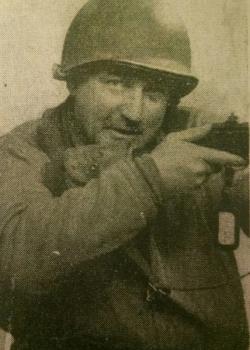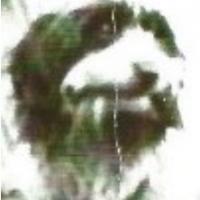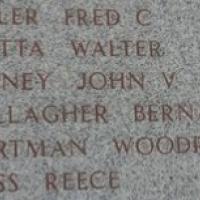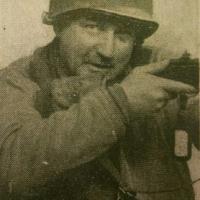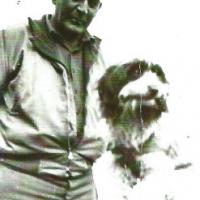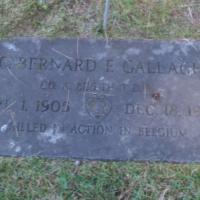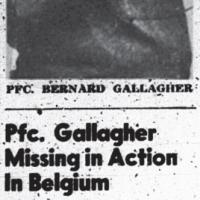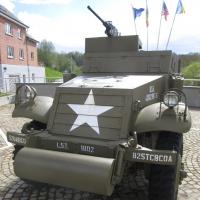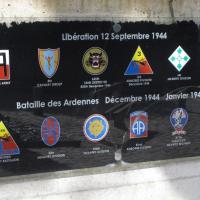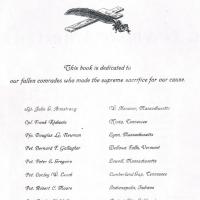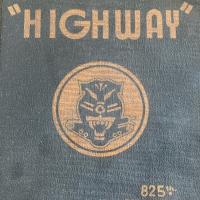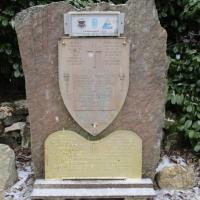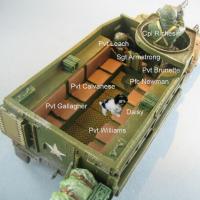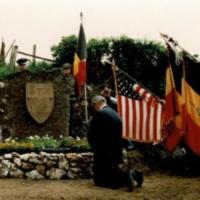GALLAGHER BERNARD F
GALLAGHER BERNARD F
Unit & Div
Born
Entered Service From
Died
Bernard F. Gallagher was born on September 1, 1905. He was the son of Mr. and Mrs. Dennis J. Gallagher of Bellow Falls Vermont. According to the census of 1940, he had four brothers (John, James, Dennis, Thomas) and two sisters (Grace and Irene). He attended the local schools in Windham County through the ninth grade. His enlistment record indicates that prior to the war, he worked in some type of warehouse, handling, loading or related occupation. He also served in the National Guard. He was the son of Dennis J. and Ellen J. Before entering service he was employed by the Moore and Thompson Parer company. He then joined the Army on September 15, 1942, at Rutland, Vermont and after his initial training was assigned to Company A of the 825th Tank Destroyer Battalion. The 825th sailed from the New York port on May 30th, 1944, aboard the Queen Elizabeth, arriving in Scotland on June 5th. After an additional two months of training, the men and equipment were loaded on LST’s and arrived on Utah Beach in Normandy, France. They were equipped with three-inch guns and initially assigned to the Communications Zone, and they performed 12th Army Group security duties between August and December 1944. Private Bernard Gallagher was part of an eight man team assigned to the First Squad, First Section, First Platoon of A Company. Sergeant John Armstrong, Corporal Frank Richesin, Private First Class Douglas Newman, Pvt Anthony Calvanese, Pvt Leo Brunette, Pvt Fowler Williams and Pvt Conley Leach made up the balance of the team. The battalion entered into combat on December 17th. They were alerted by Headquarters 12th Army Group and orders were received from the Task Force Hansen Commander. General Courtney Hodges of the First Army directed the unit to Malmedy, Belgium, with the 526th Armored Infantry Battalion and the 99th Infantry Battalion (Independent Unit with Norwegians speaking English). When the battalion arrived in Malmedy on December 18th, Captain H. Dibert immediately sent his First Platoon of A Company to Stavelot. The Fourth Squad (Second Section) of Sgt Louis Celentano joined the group later, using another way to reach the town. Meanwhile, Lieutenant Jack Doherty, commanding the 1st Platoon of A Company, had already sent his First and Second Squads (First Section) commanded by Sergeants John Armstrong and Jonas Whaley with their half-tracks and three-inch guns across the Ambleve River bridge. During this journey, the Second Squad lost track of the First because of the darkness of the night and went the wrong way, turning immediately left after the bridge. When they arrived at the end of the path, Sgt Whaley realized that they were wrong and the Squad made a U-turn. For his part, when Sgt Armstrong reached the top of the Old Castle road, he understood that it would be impossible to come into action against the German tanks, and he decided to turn back as well. Driving on the same road, the two vehicles came face to face and Sgt Armstrong’s driver, Pvt Conley Leach, skidded the half-track and its gun into a ditch on the left side. Whaley’s driver (Tec 5 William Gilman) stopped his vehicle in front of the houses on the right side. Corporal James Hammons, Corporal Leonard Walsh, and Privates Gaylord Eichorn and Willie Banes exited their vehicle to remove the gun and help the First Squad out of the embankment by hooking a cable. Corporal Frank Richesin remained in the half-track protecting his comrades with his .50 caliber machine gun. Once this task was completed, the Second Squad wanted to recover its three-inch gun, and it was at this moment that the German attack began. The two Sergeants decided to return towards the bridge without the gun. A few hundred meters below, Pvt Conley Leach overtook Sgt Whaley’s half-track and was suddenly hit by a German mortar shell. The German SS troops used a burp gun (a lightweight submachine gun) and attacked both squads from the sides. Corporal Richesin was hit and collapsed. Sgt Armstrong and Pvt Brunette went out followed by Pvt Leach, who was also hit by a burst of bullets. He collapsed with his arm on the horn. Privates Gallagher and Williams tried to open the rear door but were immediately machine-gunned by the SS troops. They fell on Pvt Calvanese, who was also badly injured but still alive. Cpl Frank Richesin then crawled out the side door and joined Armstrong and Brunette, who had taken shelter under the engine. At some point they decided to run along the houses towards the bridge. Sgt Armstrong and Cpl Richesin were shot down and new grenades were thrown. Pvt Brunette turned back and snuggled up against the bumper. The vehicle began to burn under the effect of the burp gun and the German SS troops thought that all the men were killed. One of them yelled ‘’They are all Kaput, They are all Kaput ‘’. After a while they paid no attention to the vehicle on fire, and Pvt Brunette fled to the bridge. As for Pvt Anthony Calvanese, he hid in the nearest house. In addition to Private Bernard Gallagher, five of the other men had died during the attack. The men in the second vehicle (Sgt Jonas Whaley, Tec 5 Arthel Gibson, Tec 5 William Gilman, Cpl Leonard Walsh, Cpl James Hammons, Pfc Joseph Bowen, Pvt Gaylord Eichorn, Pvt Willie Banes), when they saw what was happening to the men in the first half-track, jumped out and took refuge in the houses close by. They stayed hidden in a potato bin in a basement all day, while there were Germans upstairs. That night, they left the basement and crossed the river Ambleve at a little dam. They got soaking wet but were then able to contact men of the 30th Infantry Division, who were in town. They were given dry clothes and blankets and stayed with them until they could rejoin the 825th. They all survived. Meanwhile, the Second Section with the Third and Fourth Squads stayed on the right bank of the Ambleve river. As a result of this action, six men were killed and two were wounded. The mascot of the Unit ‘’Daisy’’ also escaped the butchery. Private Sylvio Ferrigno found the small dog a few days after the combat. The dog belonged to Pvt Calvanese and ended up its life in Wiesbaden, Germany, after being run over by a truck. There is a cenopath to Gallagher in the Saint Charles Cemetery, Windham County, Vermont.
Serge Lemaire wrote the above biography
Douglas Newman is buried at the Henri-Chapelle American Cemetery
Frank Richesin is also commemorated on the Tablets of the Missing at the Ardennes American Cemetery
Show More
Show Less
Photos (13)
View as SlideshowExternal Links

